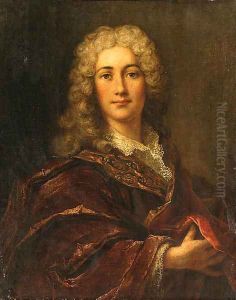School Of Nicolas De Largillire Paintings
Nicolas de Largillière was a prominent French painter during the late 17th and early 18th centuries, celebrated for his portraits and historical paintings. Born on October 10, 1656, in Paris, he showed an early inclination towards art. Largillière's family moved to Antwerp when he was very young, and it was there that he began his formal artistic training. He initially apprenticed with a landscape painter before moving to England in 1674, where he worked under the tutelage of the portraitist Sir Peter Lely.
After returning to Paris in 1679, Largillière tried to gain membership in the Académie Royale de Peinture et de Sculpture but was initially rejected. Despite this setback, he continued to build his reputation as a portraitist. His fortunes improved when he was commissioned to paint a portrait of Louis XIV, which led to his acceptance into the Academy in 1686. This commission marked the beginning of a prolific career in which he became one of the most sought-after portrait painters in Paris.
Largillière's work is characterized by a rich and vibrant use of color and a skillful rendering of textures, particularly in the depiction of fabrics and drapery. His subjects, often members of the French bourgeoisie, the nobility, and later the Enlightenment intellectuals, are portrayed with a sense of dignity and grace. He was also known for his still lifes and historical paintings, which, although less frequent, exhibit a similar attention to detail and colorism.
Throughout his career, Largillière held various important positions, including Chancellor of the Academy and Rector. He was also a mentor to many young artists. His influence extended beyond France as his works were collected across Europe. His style represents the transition from the grandeur of Louis XIV's reign to the more intimate and personal rococo style that would come to dominate the 18th century.
Nicolas de Largillière passed away on March 20, 1746, leaving behind a vast oeuvre that has been celebrated for its artistic merit and historical significance. His portraits provide a window into the social and cultural milieu of his time, capturing the essence of an era on the cusp of Enlightenment.
